

【2019年5月1日 東京発】
2019年、子どもの権利条約は採択から30周年を迎えます。
子どもの権利条約は、18歳未満を子どもと位置付け、世界のすべての子どもたちに、自らが権利を持つ主体であることを約束しています。
「子どもの権利条約」は、世界で最も広く批准されている国際人権条約です。
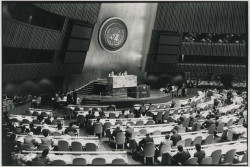 |
|
©UNICEF/Ruby Mera |
|
1989年11月20日、国連総会で、「子どもの権利条約」が採択された。 |
30年前、世界で一つの歴史的な出来事がありました。
世界のリーダーたちが国連に集い、話し合い、世界の子どもたちのための重要な決断をしました。そこで生まれたのが、すべての子どもの権利を定めた「子どもの権利条約」です。
「子どもの権利条約」は、1989年の誕生以来、世界の子どもたちの状況の改善に大きな役割を果たしてきました。多くの国々が、この条約でうたわれている子どもの権利の実現と、子どもたちが直面する課題の解決に向けて、法律や政策を改め、予算をふやし、力を注いできました。
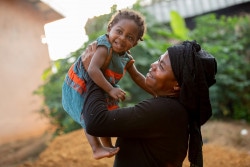 |
|
© UNICEF/UN0252805/Schermbrucker |
|
治療によりHIVの母子感染を予防することができた、アントワネットさんと娘のナターシャちゃん。(カメルーン) |
それらの成果の一つとして、年間1250万人だった5歳未満児死亡数は、年間540万人へと半減しています。そして、多くの子どもたちが学校に通えるようになり、児童労働から解放されたことで、子どもらしく生き、自らの持つ能力を最大限に伸ばす機会を得ることができるようになりました。
「子どもの権利条約」は、人身売買や性的搾取などといった子どもを取り巻く課題に対して、国際社会が一丸となって取り組む原動力にもなっています。
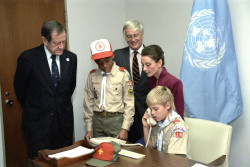 |
|
© UNICEF/UN0279229/John Isaac/UN Photo |
|
1989年11月19日、子どもの権利条約採択について在ジュネーブの国連オフィスに報告するボーイスカウトの男の子たちと、ユニセフ事務局長ジェームス・グラント(写真左)、ユニセフ親善大使オードリー・ヘップバーン。 |
1989年に採択された子どもの権利条約は、2019年11月20日で採択から30年の月日が経過します。
30年前、ユニセフは、子どもの声を代弁する国連機関として、「子どもの権利条約」の草案づくりにも参加し、各国がこの条約に入るよう全世界で懸命に働きかけました。
そうした成果が実り、2019年現在、「子どもの権利条約」は、国連加盟国数を上回る196の国と地域で締約され、世界で最も広く受け入れられている人権条約となりました。とても素晴らしいことである一方で、「子どもの権利条約」を締約しただけでは、子どもの権利は守られるようになりません。
子どもに関わるすべての人が、この条約にうたわれている権利が実現されるように取り組むことが必要です。そして何よりも、子どもたち自身が、自分たちの持つ権利について知り、学び、声を上げていくことがとても大切です。
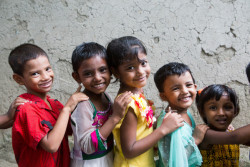 |
|
© UNICEF/UN046741/Haque |
|
ユニセフが支援する就学前教育に参加する子どもたち。(バングラデシュ) |
この30年で、世界は大きく変化し、子どもを取り巻く環境も劇的に変わりました。
しかしながら、子どもが子どもらしく生き、健やかに成長し、未来を描けるように、すべての人が努力しなくてはならない、ということはいつの時代にあっても同じです。
現在の世界を見わたすと、4人にひとりの子どもが災害や紛争などの緊急事態にある国や地域で暮らし、移民や難民となって移動している子どもも大勢います。インターネット上で被害を受ける子どもを保護するかなど、新たな課題も生まれています。
ユニセフは「子どもの権利条約」のもと、過去も現在も、すべての子どもが、子どもの権利条約で保障された権利を享受できるように、世界中で活動しています。
|
* * *
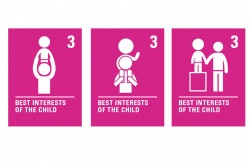 |
|
子どもの権利条約第3条のアイコン候補 「子どもにもっともよいことを:子どもに関係のあることを行うときには、子どもにもっともよいことは何かを第一に考えなければなりません。」 |
子どもの権利条約採択30周年にあたり、ユニセフは世界中で、子どもの権利条約のそれぞれの条文のアイコンを選ぶオンラインアンケートを実施しています。選ばれたアイコンは後日ホームページで発表します。6月14日までですので、ぜひ、あなたが良いと思うアイコンに投票してください。
<追記>
2019年10月7日、子どもの権利条約採択30周年 各条文のアイコンが決定しました!
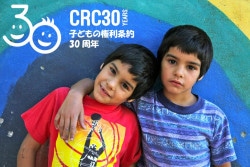 |
|
© UNICEF/UNI144419/Pirozzi |
日本ユニセフ協会は、子どもが主題の映画を上映するユニセフ・シアター・シリーズ 「子どもたちの世界」を開催いたします。
「そもそも子どもとは」「それでも生きていく子どもたち」「子どもを取り巻く世界」「女の子・女性の権利」の4つの視点から選んだドキュメンタリーとフィクション計12作品を5月~12月の間、毎月連続で上映いたします。
子どもたちが置かれている状況、成長していく姿、そして、彼ら彼女たちがつくり上げていく世界への希望。映画を通じて一緒に考えてみませんか。
シェアする